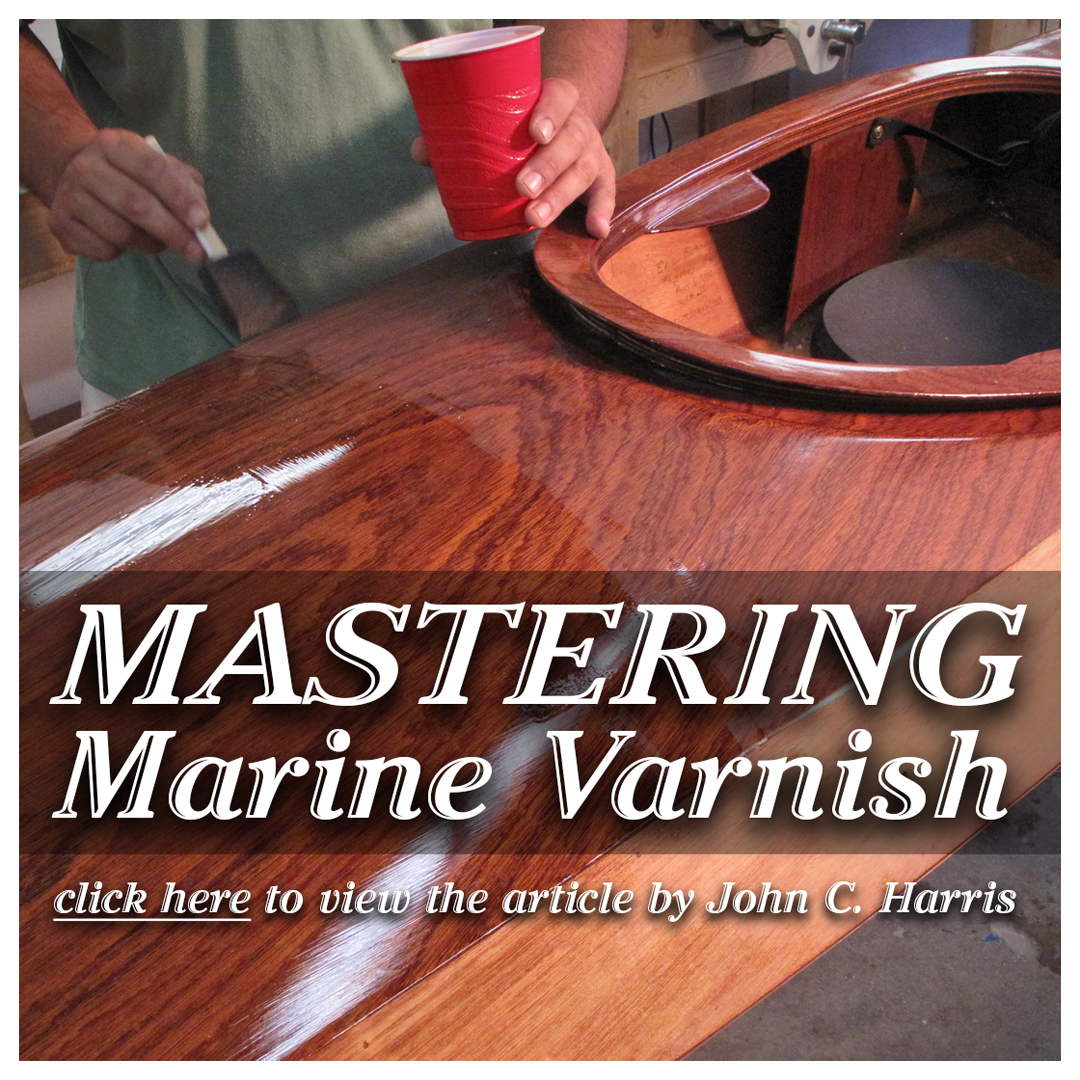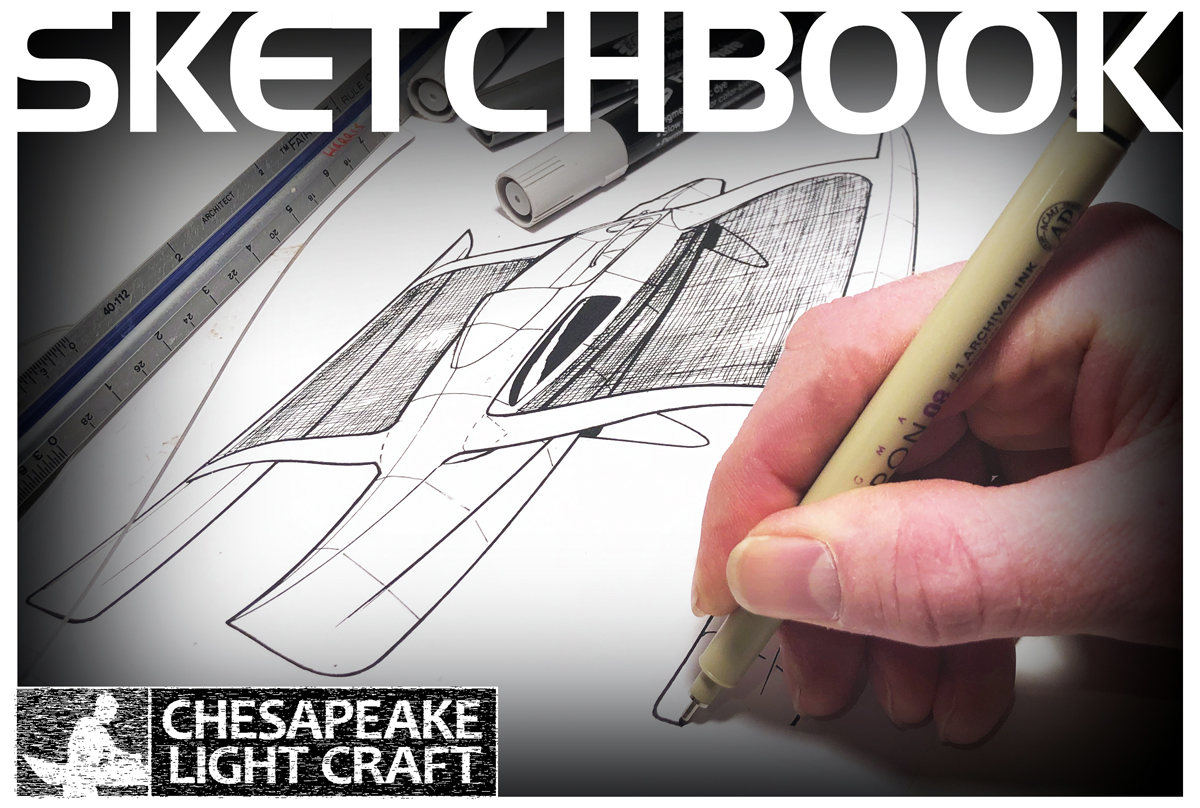Builders' Forum |
|
| ↓ Scroll to Last Comment ↓ | Forum Guidelines | Builders' Forum | |
Finding varnishing rather challenging
I have just begun to varnish my Chester Yawl floors, seat, footbrace, and boat interior. It isn't going as well as I would like and I hope that maybe you have some ideas. I will tell you a little more about what is going on.
I am using the recommended Schooner Varnish and the Goldspar Satin.
I took John’s recorded warning about dust seriously and spent a couple of days cleaning my shop, including mopping the floor. But It is a shop and not amsterile paint booth. I also note that I have been keeping the temp in the shop around 70°F.
My epoxy has been sanded to 320 and I believe it is in pretty good shape. I went to 320, instead of 220, as I could still see sanding scratches at 220. I wiped everything down with alcohol and paper towels. I have watched John's video #13 on varnishing a bunch of times and read the tips article a number of times as well. I am using the 2" foam brushes from CLC that are mounted via plastic inserts - I bought the full box. These break almost immediately when I varnish. This is not an issue I had so often when working with the epoxy as I used these brushes for tipping, and for finishing where the rollers didn't fit.
The smaller parts went easier than the boat interior, but while they leveled well, they show lots of very tiny bubbles. This is just a first coat but it's not what all those pretty CLC boats that are finished bright look like at all.
On the boat interior I did get a few runs where I was working in tight spaces, for example in the corners under the seats, and under the outwales as well (I think I just need to get down lower and go slower on those). The interior is a huge space compared to John's kayak in his video. My strategy was to do the stern, the stern deck, and then each side of each bay between bulkheads/ribs working side to side and then forward, followed by the front deck and then finishing with the outwales and braces. As each brush handle only lasts a couple of minutes, I just tossed it and handled the foam directly. As the finished spaces are mostly confined, I find it difficult to work from dry surface onto wet as I work my second direction.
All suggestions would be greatly appreciated, but here are some specific questions: Did you recommend the CLC foam brushes or do you prefer someone else's, or even a different means of applying the varnish? I know that CLC's tips say to use foam brushes with wooden inserts into the foam, but this is not what they are selling. What size brush do you use? Do you thin the varnish so that there is less drag and more open time (I am using a brand new can of Schooner Varnish and poring about a half cup of varnish into a clean yogurt container at a time). Do you use different techniques for applying the varnish on a larger boat or in restricted areas?
The epoxy drove me crazy too, but I did learn some as I went. I am not sure that I goofed when I changed my mind and went bright inside instead of painted. Now I really want it to come out right.
Pictures can be seen on Facebook under the #clcchesteryawl tag. I bet I am the only one using it presently, but I am Brett Binns on Facebook if there is any question.
9 replies:
RE: Finding varnishing rather challenging
��I did most of my varnishing on my skerry with the foam brushes. While the ones from CLC were better than the big box, they still deteriorated faster than I expected. I did my rails, breasthooks bright and painted the rest, but I also varnished the spars rudder and board. Lately I've been going back to a bristle brush and may stick with it. I don't have the super fancy hand made badger bristle with brass fittings made for stupid sums by Olde Worlde craftsmen. I got a couple decent ones from the hardware store. Clean them with mineral spirits and wrap them to keep flexible. Schooner varnish flows well and I don't seem to get many bad spots. Just keep a light touch and not too much varnish in the brush or runs happen. Mind you, none of my work will ever go in a museum but from 10 feet, looks pretty good.
RE: Finding varnishing rather challenging
Right, that's a good goal: "from 10 feet, looks pretty good." <;-) We also found that paint can look pretty good from closer than that, so we limited the varnished areas on our Passagemaker Dinghy to the outsides of the bow and stern transoms, and the curved doublers in the inside above the bow and stern seats.
My son, who, together with his bride (she's a pretty good hand with a brush--I'm a klutz) was going to take charge of the painting, initially wanted to varnish the whole business. I responded, "it's a boat, not a Martin guitar. Varnish is a tool of the devil meant to enslave mankind to his own vanity. Paint is God's gift of grace to fallable boatwrights to cover their imperfections." In the end, he was glad I talked him out of it, as even the small areas he did varnish vexed him some.
But, don't let me discourage you, Brett. By all means, get a decent hardware store brush as suggested above and try that. Even the small areas we varnished were giving us some the same troubles you describe until we went for the brush. He also found it helped to tilt the areas some so they were less vertical (our PMD is a take-apart)--easier to avoid runs.
Good luck!
.....Michael
RE: Finding varnishing rather challenging
Gramps -
"Varnish is a tool of the devil meant to enslave mankind to his own vanity."
Best. Comment. Ever.
RE: Finding varnishing rather challenging
You folks are great! Much thanks. I enjoyed the laughs too!
RE: Finding varnishing rather challenging
Brett,
I varnished the decks of two Chesapeake kayaks and still remain very pleased with the results, despite being a complete and total "klutz with a brush", I ended up with what I consider a five foot finish.
Before varnishing the boats I looked around for alternatives and found a couple of articles about wiping varnish.
https://www.popularwoodworking.com/techniques/finishing/the_basics_of_wiping_varnish2
Which seemed to be nothing more than thinned varnish that was slopped on and immediately wiped off. I tried a couple of coats and was very impressed with the finish. This gave me the confidence to go ahead and start brushing on the varnish, with the thought in my hjead that if I completely screwed up I would just sand down my mistakes and finish off with a number of coats of wiping varnish.
When brushing with the foam brushes I had the same problem you described with the brushes breaking, I kept my back pockets filled with spare foam brushes and the second one broke I would replace it and keep moving. The end result being that the more I varnished the better my technique became and I didn't need to go to the wiping varnish backup plan.
I finished the kayaks with a painted hull and a bright deck and despite how well they paddle the most pleasing thing to me when paddling is watching the deck grain come alive in the sunlight.
Have fun,
Dave
RE: Finding varnishing rather challenging
FWIW, my local Ace Hardware carries foam brushes in which the wood handle extends into the foam. I’ve found these to quite sturdy. The printing on the handle carries a registered tradename “POLY-BRUSH” and they are made in the US by JEN MFG.
hokker
RE: Finding varnishing rather challenging
That is inspirational, SignsEHT! Hokker, I will definetly see if I can't find those. Very helpful - thanks everyone!
I might manage to get another coat on before getting on the road for a spell, but likely will have to wait until May. In any case, that gives me a chance to see if I can't find those better brushes.
RE: Finding varnishing rather challenging
I found the same brushes that hokker mentions above at Viking Lumber and they work so much better than the ones available at CLC. The wooden stick penetrates the foam and is split on the end so that it contains a rectangular pies of plastic that is stapled in place. This keeps the foam reasonably stiff. The CLC brushes chatter as they pull through the varnish and quickly become staturated, floopy, and unusable. The JEN MFG brushes stand up far longer and always glide smoothly. I completed a full pass on my Chester Yawl interior, the floor board, seat and foot rest with a single brush (though it might be I shouldn't be so frugal and should have changed it). I would recommend folks find these instead of other brushes. Much thanks to hokker for recommending them!













RE: Finding varnishing rather challenging
» Submitted by Laszlo - Fri, 3/16/18 » 8:13 AM
>>Did you recommend the CLC foam brushes
They've always worked for me, much better than the DIY store ones I tried
>> even a different means of applying the varnish?
I've also rolled it on and then tipped it out with the same foam brushes. That worked well for the undercoats, but the top layer always looked better applied with the foam brushes.
>>I know that CLC's tips say to use foam brushes with wooden inserts into the foam, but this is not what they are selling.
Yes, that's a shame. I preferred the old ones but apparently they are no longer available.
>>What size brush do you use?
Same as you
>>Do you thin the varnish so that there is less drag and more open time
No
>> Do you use different techniques for applying the varnish on a larger boat
Just the roller as mentioned above
FWIW, even the new plastic insert brushes have not broken for me. EIther you have a bad batch or are pushing a lot harder than I do. I've also noticed that if I push hard I get bubbles that aren't there when I push lightly.
Good luck,
Laszlo